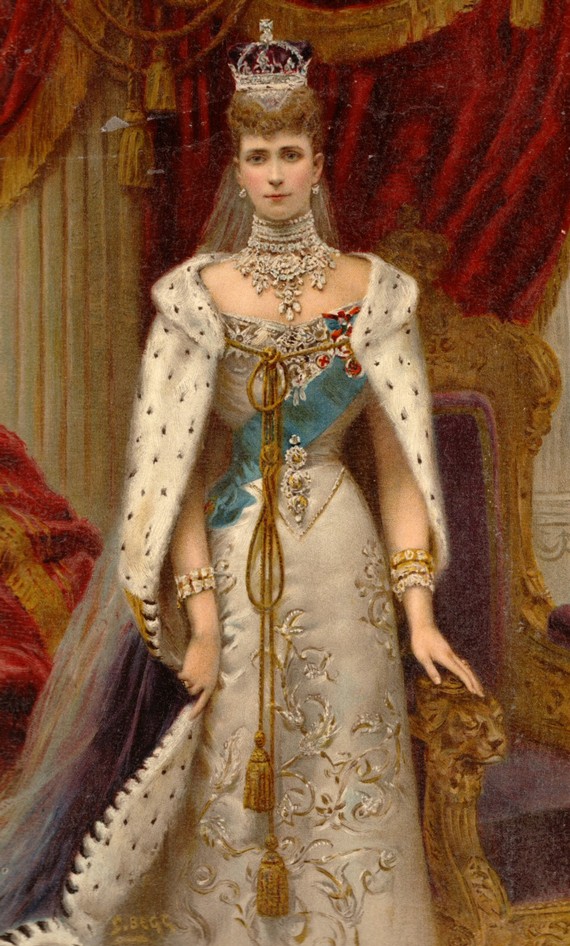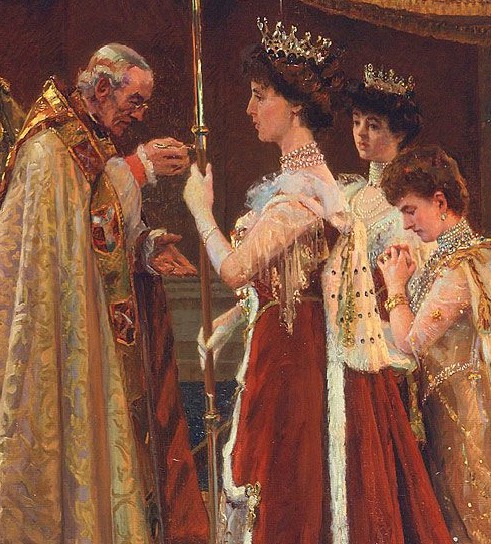Edwardians Kings Gallery Review – Mostly Glitter and Glamour
July 17, 2025Edwardians Kings Gallery Review. The Edwardians: Age of Elegance. If you’re after a little escapism with your art history—diamond tiaras, garden parties, and royal swagger all included—then you’d do well to saunter into The King’s Gallery at Buckingham Palace this summer. The Edwardians: Age of Elegance is an unabashedly sumptuous exhibition, an opulent promenade through the last gasp of an era before war reshaped everything. It’s not just beautiful—it’s fascinating, often poignant, and occasionally absurd.
What makes this show shimmer isn’t just the sparkle of Fabergé or the flutter of feathered fans. It’s the way the curators have drawn out the personalities behind the pieces. This is a show not only about society portraiture and couture coronation robes—it’s also about the cultivated image of monarchy, the invention of modern celebrity, and how the House of Windsor learned to dazzle in public while shielding its private self.
Edwardians Kings Gallery Review – Setting the Scene
The exhibition unfolds in three stages—each more revealing than the last.
The first gallery evokes the “private world” of the Edwardian royals: overstuffed writing desks, intimate pencil sketches, watercolours, photographs, snuff boxes, embroidery, and framed doodles. It’s like rummaging through Queen Alexandra’s memory box, and it’s also utterly charming.
The second gallery glows with state glamour: bright red walls and ceremonial pomp. You’ll find court portraits, jewels, coronation gowns, and a feast of fashion. It’s the theatre of royalty in full performance mode, and it’s glorious.
But just when you think it’s all picnic hampers and peerages, the mood shifts. The final gallery turns sombre, tracing the start of World War I and the transformation of monarchy from lavish to dutiful. Photographs of Queen Mary visiting bomb sites and portraits of wounded soldiers quietly replace the glitter with grit. It’s a poignant denouement.
Gallery One: Whispered Luxuries and Intimate Details
To begin, we’re in the domestic sphere—not drawing rooms or state banquets, but bedrooms, sitting rooms, and garden corners. This is where we see Queen Alexandra not as a figurehead but as a woman with hobbies and affections. She was a keen amateur photographer, and some of her early Kodak snaps are on display—surprisingly modern in their casualness.
There’s a beautiful sense of texture to this first room. Embroidered purses, hand-painted fans, and sketchbooks bring a personal warmth. One highlight is a set of drawings of Princess Louise (Queen Victoria’s daughter) who, in a pleasingly subversive twist, insisted on being portrayed not in finery but in her riding gear.
Here too are gifts and tokens from the royal family’s glittering circle: an inscribed volume from Oscar Wilde, musical scores signed by Puccini, a Fabergé flower in a little crystal vase. You feel the weight of relationships—some formal, some deeply affectionate.
If you like to linger over calligraphy or inspect the clasp on a locket, you’ll find this room irresistible.
Edwardians Kings Gallery Review Gallery Two: Gold Thread and Diamond Fire

Queen Alexandra in coronation robes, 1902
Samuel Begg, Public domain, via Wikimedia Commons

The Anointing of Queen Alexandra at the Coronation of King Edward VII, 1902. Laurits Tuxen, Public domain, via Wikimedia Commons
And now we step into high drama. The middle gallery—painted a deep, theatrical red—is where the show goes full diamonds and embroidery.
Centre stage is Queen Alexandra’s coronation gown from 1902. And what a dress it is. Made of golden silk tissue, it’s embroidered with the floral emblems of the UK: rose, thistle, and shamrock, twining up the folds. It was created by Madame Blossier of Paris and hand-finished by Manick Chand in India, its metallic shimmer captured under careful lighting.
Jewels and Portraits
The jewels are another matter entirely. They’re arranged like constellations in glass cases—dazzling, yes, but also a bit aggressive in their splendour. Among them: the famous Kokoshnik Tiara (inspired by Russian folk headdresses, gifted by the “Ladies of Society”), diamond stomacher brooches the size of a salad plate, and Fabergé boxes designed with such frivolous delicacy that one forgets they were once the day’s equivalent of a £30k thank-you note.
There are also portraits, too—exquisite and enormous. Laurits Tuxen’s depictions of garden parties and court scenes are staged like opera: all swirling silk, monocles, and clipped conversation. Nearby, John Singer Sargent paints royalty as slightly amused aristocrats, their inner lives glimpsed in a raised brow or a languid wrist. Queen Alexandra appears as a near-mythical creature in white lace, Sargent’s brush practically swooning over the details.
For fashion historians, it’s a goldmine. Corsetry and surface embellishment. Tea gowns and royal uniforms. Accessories not merely decorative but declarative. This was an age when image was everything—and it shows.
Edwardians Kings Gallery Review Gallery Three: A Change in the Air
Just when the glitter begins to feel intoxicating, we reach the exhibition’s final room—and the tone drops, the colours mute, the space hushes.
Here, we find Olive Edis’s black-and-white photographs of WWI soldiers, many of them wounded, some of them decorated. Queen Mary—so often portrayed as aloof—is shown at bomb sites and hospitals, her hat immaculate, her expression clear and unfaltering. George V stands beside the coffin of the Unknown Warrior. Suddenly, these royal figures are not ornaments but symbols of continuity, struggling to retain relevance in a world torn by mechanised warfare.
This final turn is perhaps the show’s quietest triumph. It doesn’t preach, but it suggests: the Edwardian world, for all its lace and tiaras, was not blind to change. It was perched on the brink of the modern. The fantasy of elegance had to adapt—or vanish.
But…
There’s little overt mention of empire’s darker dimensions, of colonial extraction, of the exploitation that often funded these baubles. Edward VII’s notorious infidelities are given a discreet pass. The working classes—the majority of Edwardian Britain—are barely visible.
And yet, The Edwardians: Age of Elegance isn’t a sociological takedown. It doesn’t aim to dismantle its subject. Instead, it presents the age on its own shimmering terms—and quietly lets the cracks show.
There’s something to be said for that. Beauty, after all, is not apolitical—but neither is it unworthy of study. The show allows us to luxuriate, but it also makes us ask: what does elegance obscure? What did it protect? And what traces of it also remain in our own cultural spectacles?
Details:
The Edwardians: Age of Elegance is on at The King’s Gallery, Buckingham Palace, London
Until 23rd November 2025. Admission: £19.00 (concessions available including £1 tickets).


